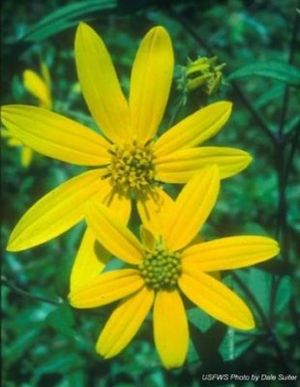Helianthus schweinitzii facts for kids
Quick facts for kids Helianthus schweinitzii |
|
|---|---|
 |
|
| Conservation status | |
| Scientific classification | |
| Genus: |
Helianthus
|
| Species: |
schweinitzii
|
Helianthus schweinitzii is a special type of wild sunflower. It is also known as Schweinitz's sunflower. This plant grows naturally only in the Piedmont region of North Carolina and South Carolina. It is part of the large sunflower family, called Asteraceae.
Schweinitz's sunflower is one of the rarest sunflowers in the United States. There are only about 90 groups of these plants known today. Many of these groups have fewer than 40 plants. Because it is so rare, the U.S. Fish and Wildlife Services declared it an endangered species on May 7, 1991. This means it needs special protection to survive.
Contents
Who Discovered Schweinitz's Sunflower?
Botanists are scientists who study plants. Two famous botanists, John Torrey and Asa Gray, first wrote about this sunflower in 1842. The plant is named after Lewis David von Schweinitz. He was a clergyman and botanist from Salem, North Carolina. He was the first person to find this unique sunflower.
What Does Schweinitz's Sunflower Look Like?
Schweinitz's sunflower is a tall plant. It can grow from 3 to 13 feet (1 to 4 meters) high. Some plants can even reach 16 feet! This sunflower is a perennial plant. This means it lives for more than two years. It grows back each year from its roots.
Roots and Stems
Underground, the sunflower has special parts called tubers and rhizomes. These help the plant store food and spread. Its stems are usually purple and grow straight up. They only branch out near the middle or top of the plant.
Leaves and Flowers
The leaves of Schweinitz's sunflower are thick and stiff. They often hang down a bit at the ends. The plant blooms for about two to three weeks in early October. Each plant usually produces 3 to 6 bright yellow flower heads. Each flower head has 8 to 15 ray florets (the "petals") around the outside. Inside, there are 40 or more disc florets (the tiny flowers in the center).
How Does It Spread?
This sunflower spreads its seeds without a rest period. This means the seeds can start growing right away.
Where Does Schweinitz's Sunflower Live?
Schweinitz's sunflower is found only in the Piedmont region of North and South Carolina. This area has specific types of soil. The sunflower often grows in shallow, poor, or rocky clay soils.
Ideal Growing Conditions
This flower grows best where it gets a lot of sunlight or some partial shade. Many groups of these sunflowers are found along power line paths or roadsides. In 2003, about 80% of all known groups were near railways, utility roads, or roadsides. Today, 13 known groups exist in North Carolina.
Protecting Schweinitz's Sunflower
The U.S. Fish and Wildlife Services listed Schweinitz's sunflower as "Endangered" on May 7, 1999. This means it is at high risk of dying out. There is no special "critical habitat" area set aside just for this sunflower.
Conservation Efforts
All known groups of Schweinitz's sunflower are watched closely. Scientists check on them to see how they are doing. While the number of individual plants has gone up in some places, it has not increased enough everywhere. This means the sunflower still needs a lot of help.
Main Threats to the Sunflower
This rare sunflower lives in areas that are developing quickly. This means human activities are a big threat. Some dangers include:
- Building new homes or businesses.
- Work by utility companies.
- Making roads better or wider.
- Not having natural fires. Fires can help clear land for the sunflower to grow.
Laws That Help
The Endangered Species Act of 1973 is a law that protects the sunflower and other rare plants. In North Carolina, the Plant Protection Act also helps. It makes it illegal to collect or sell these flowers without a special permit. South Carolina has a law that stops people from damaging or taking plants from state-owned land.
There is no international listing for Schweinitz's sunflower yet. This means it is not listed by the International Union for Conservation of Nature (IUCN).
Images for kids



